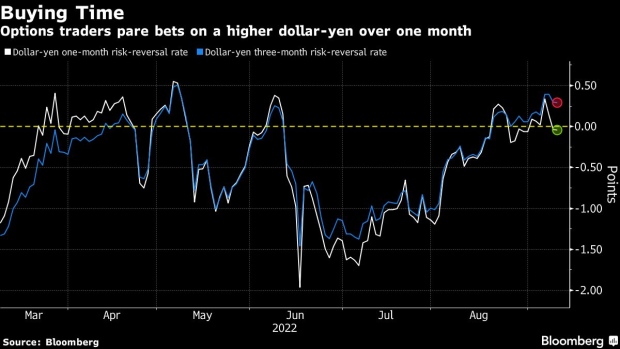Sep 8, 2022
Yen Catches Breath From Selling as Authorities Seek to Buy Time
, Bloomberg News

(Bloomberg) -- The yen rebounded Friday as traders mulled comments from Bank of Japan Governor Haruhiko Kuroda on the currency’s decline amid a broad dollar selloff.
The dollar-yen pair fell 1.3% to around the 142.20 level, after climbing for four straight sessions. Kuroda held a meeting with Prime Minister Fumio Kishida in a sign of the nation’s heightened alert levels.
“Sudden moves in foreign exchange rates increase uncertainty for firms and are undesirable,” Kuroda told reporters Friday after the first gathering of the two since June. “A two to three yen move against the dollar in a single day is very sudden.”
Kuroda’s comments follow Thursday’s three-party meeting that sought to communicate a sharp ramping up of concern from officials, who gave their strongest hint yet that direct currency intervention was among the options available to them.
That message continued Friday afternoon, when Chief Cabinet Secretary Hirokazu Matsuno reiterated his stance that the recent moves in the yen were excessive and all options remained on the table.
Japan’s acute policy divergence on interest rates with the Federal Reserve has piled pressure on the yen this year, causing it to slump some 20%. While other central banks, including the European Central Bank on Thursday, are racing to raise rates, the BOJ is keeping them at rock-bottom levels.
“Markets likely took Kuroda’s comments as an opportune trigger to unwind stretched positions, particularly since hawkish ECB messaging yesterday reminded markets that the hawkish Fed is not the only game in town,” said Yanxi Tan, foreign exchange strategist at Malayan Banking Bhd in Singapore. “The extent of USD/JPY move today is roughly on par with that in broader dollar softening.”
An option’s market gauge of expected direction for the pair over one month dipped into negative territory, suggesting a paring of bets on further gains over that time period.
But its three-month equivalent still pointed to a preference for wagers on a further yen decline.
“Behind the scenes, I think the government is increasing pressure on the BOJ,” said Nobuyasu Atago, chief economist at Ichiyoshi Securities and former BOJ official. “I think Kishida is paying close attention to his falling support rate in the polls, and he may set his eyes on the central bank because it’s the BOJ that’s adding to inflation with the weaker yen. Intervention is very difficult as it concerns the US too.”
The US has so far made clear that it would be reluctant to support any potential stepping in to the currency market by Japan. In July, Treasury Secretary Janet Yellen said Group of Seven nations should have market-determined currency rates.
A Trader’s Guide to Japanese Policy Makers’ Language on the Yen
“Japanese authorities are just buying time,” said Jun Kato, chief market analyst at Shinkin Asset Management in Tokyo. “Their verbal warning merely is effective in giving a catalyst to spark a correction to the rapid pace of currency moves.”
Should the move swing back, traders will be watching for a break of 145 in the dollar-yen, which touched 144.99 on Wednesday. They are also keeping an eye on 146.78, the level reached before joint Japan-US intervention to support the yen back in 1998.
The dollar saw a broad decline against major peers Friday after the hawkish ECB meeting cooled demand for the world’s reserve currency.
The BOJ will give the latest results of their policy meeting on Sept. 22. But analysts have thrown doubt over how much verbal intervention can stop the relentless yen slide, with currency traders focused on fundamental interest rate differentials.
BOJ Should Tweak YCC for Yen Stability, Former Executive Says
Former BOJ Chief Economist Hideo Hayakawa said this week the Japanese central bank should be the one to take action to contain the yen’s volatility. In his view, the BOJ’s long-term rates peg is the chief cause behind the yen’s rapid weakening.
(Updates with comment from chief cabinet secretary.)
©2022 Bloomberg L.P.





